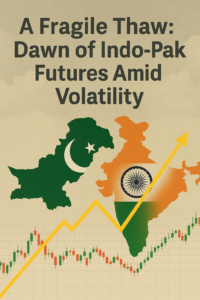“Indo-Pak Future: Between Hostility and Hope”
Introduction
The relationship between India and Pakistan has always been a blend of rivalry, mistrust, and occasional cooperation. From the battlefields of history to the corridors of diplomacy, the two nations stand at a complex crossroads. As the 21st century advances, their future seems shaped not just by political will, but by economic realities, public sentiment, and the unpredictable swings of geopolitics.
1. Historical Shadows that Linger
No discussion on the Indo-Pak future can begin without acknowledging their shared history. Partition in 1947 left deep wounds, wars reinforced mistrust, and the Kashmir dispute remains unresolved. These shadows continue to influence decision-making and limit progress.
2. The Geopolitical Chessboard
Both nations occupy a crucial position in South Asia. While India strengthens ties with the US, Japan, and the West, Pakistan leans on China and Gulf allies. Global shifts — such as the rise of BRICS, China’s Belt and Road Initiative, and changing US policies — will directly shape how New Delhi and Islamabad engage in the coming decades.
3. Economic Interdependence: A Missed Opportunity
Trade potential between the two countries is massive, estimated by some economists to exceed $37 billion annually. Yet political restrictions, high tariffs, and security concerns have kept official trade minimal. Economic cooperation, if revived, could reshape the region’s prosperity.
4. People-to-People Connections
Despite political hostility, cultural similarities, shared languages, and diaspora networks keep some bridges alive. Cross-border sports, academic exchanges, and humanitarian initiatives could be powerful tools in softening rigid stances.
5. Possible Scenarios for the Future
-
Optimistic Path: Resumption of dialogue, gradual trust-building, joint economic ventures, and reduced military tensions.
-
Status Quo: Sporadic talks, frequent border skirmishes, and slow progress.
-
Pessimistic Outcome: Escalation of disputes, more military stand-offs, and complete diplomatic freeze
-

Conclusion
The Indo-Pak future is not carved in stone — it is a living equation shaped by leadership choices, public attitudes, and external pressures. Peace may not be easy, but the cost of perpetual hostility is far higher. Both nations stand to gain far more from cooperation than confrontation, making dialogue not just desirable, but essential.
Overview / Key Points
-
Shared history continues to influence Indo-Pak relations.
-
Geopolitical alliances are pulling both nations in different directions.
-
Economic cooperation remains an untapped goldmine.
-
Cultural and social ties offer potential pathways to peace.
-
The future will depend heavily on political will and regional stability.
Vocabulary for CSS/GRE Prep
| Word | Urdu Meaning | Origin & Root | Definition | Synonyms | Antonyms | Example Sentence |
|---|---|---|---|---|---|---|
| Hostility | دشمنی | Latin hostis (enemy) | Unfriendly or antagonistic behavior | animosity, enmity | friendship, goodwill | “Decades of hostility have hindered Indo-Pak trade.” |
| Prosperity | خوشحالی | Latin prosperus (favorable) | State of being successful and wealthy | affluence, success | poverty, hardship | “Peace could bring prosperity to South Asia.” |
| Diplomacy | سفارت کاری | Greek diploma (folded paper) | Managing international relations | negotiation, tact | aggression, confrontation | “Diplomacy can help resolve the Kashmir issue.” |
| Tensions | کشیدگی | Latin tendere (to stretch) | Strained relations or situations | strain, friction | harmony, ease | “Border tensions have risen in recent months.” |
| Cooperation | تعاون | Latin cooperari (work together) | Working jointly towards a goal | collaboration, alliance | conflict, division | “Trade cooperation could transform Indo-Pak ties.” |

